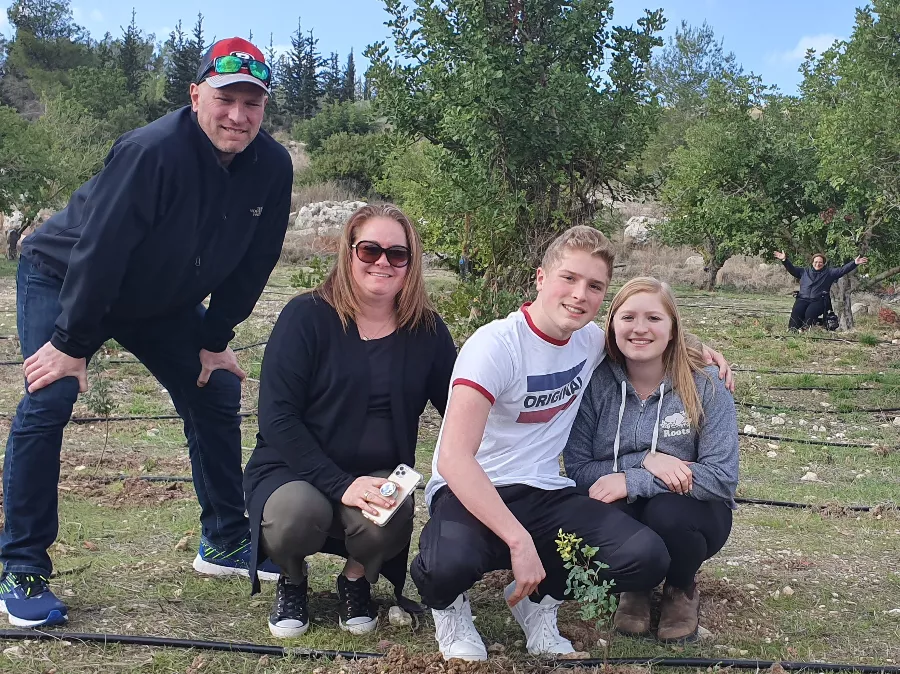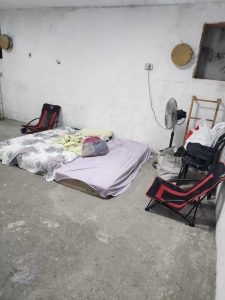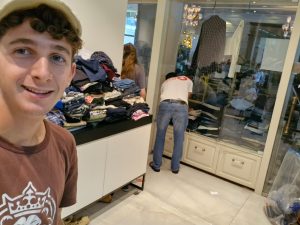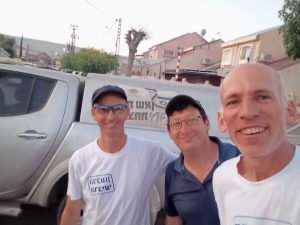It is a well-known and wonderful tradition in Israel to plant a tree. Families, schools and youth movements have embraced the tradition of going out and planting trees on the day of Tu Be’shvat in early springtime. Jews and non-Jews around the world have been supporting this project by “sponsoring” trees, mainly through the Jewish National Fund (JNF)- Keren Kayemet Le’yisrael (KKL) organizations and other initiatives. This national mission of planting trees on the denuded hills of Israel has visibly changed the country’s landscape. As you drive the length and breadth of the country, you see forests of tall trees – pines, cypress, carobs and many others – forming large green areas between the towns and cities.
As a tour guide, I often engage my visitors in a discussion regarding the forests and trees we see around us. Some of us tour guides do this out of love and appreciation for nature and trees; others out of love and connection to the Zionist pioneering story; and many of us, out of a combination of both. We might include a description of the extensive forest landscapes of biblical times, and today’s landscapes, the names and types of trees, plants, and vegetation we see around, their characteristics, stories, and legends. In addition, we discuss the loss of the forests in the region during the 19th centuries due to the uncontrolled over grazing of herds (mostly the black goat) and too widespread growth of deforestation (cutting down trees) for man’s needs. Talking about Zionist afforestation sets the background to the story of the pioneering efforts of the Zionists, who returned to a bleak land and planted trees in order to reestablish and rehabilitate the impoverished land. Less often, but nevertheless important, I might delve into topics such as the transition into biosphere reserve, or the amazing results we have accomplished in the field of savanazation (desert-foresting), an innovating and ground breaking project started in the south of Israel in the Negev region, not far from the city of Be’er Sheva.
When I speak to my guests about the forests, it is common for one or more of the people on the bus to burst out and recall that they once donated towards a Tree in Israel; sometimes they even remember receiving the colorful JNF certificate attesting that a tree was planted in Israel in honor of their Bar/Bat Mitzvah or some other special occasion. Inevitably, the million-dollar question pops up: “Can you show me MY tree?”. As a tour guide, I always look for an opportunity for a quick little laugh, so I just point out the window and say, “Take your pick”, which usually creates a rolling chuckle, and an opportunity to hear from everyone in the group about their Tree in Israel.
On a serious note. Having the opportunity while in Israel to plant your own tree is an amazing experience: getting out in the field, kneeling down on the ground and dirtying your hands in the soil, carefully pulling the thin sapling from its plastic bag and placing it in the hole, gently covering its roots, with the dirt, and then praying and hoping it will make it through its first summer, and someday be part of a big forest, with families sitting in its shade and kids playing in the parks around. This is one of my favorite things to do with guests in Israel. Whether it be in a private home like in my back yard, or in a new farmstead. Whether it be part of a volunteering and donation project at a school, or children’s home, a hospital or a seniors’ assistant living. Or, whether it be in one of the many JNF-KKL forests around the country, depending on the area and the season of the year.
I particularly like to take the ride down to the Tzor’a Forest, several kilometers off the Tel Aviv-Jerusalem highway, just off Road 38, not far from the city of Beit Shemesh. This is the heart of the region known as Shfelat Yehuda (Judean Foothills). The region is blessed with fertile valleys and rolling rocky hills that reach a maximum elevation of four hundred and fifty meters above sea level. The area serves as a middle ground between the high mountains of Judea and Jerusalem to the east, and the Mediterranean coastal plain to the west. The hills are covered today in a lush and green forest, mainly pine tress planted by the JNF-KKL, and other trees, such as the Alon (oak)or the Ella (pistacia). The evergreen carob trees, olives and figs add to the rich forest landscape of the region. The roots of the trees hold the earth together, preventing erosion of the hill soil into the valleys below. Those valleys, between the forested hills, are cultivated by farmers growing grains (wheat and barley), olive groves, vineyards, cotton fields, sunflowers and more. It is a great view, a nice drive, and a wonderful area for picnics, strolls, biking and outdoor fun.
As we drive through the region, we note the special brown road signs directing us to the region’s geographic and historical points of interest, referring to the ancient biblical history of the area on the one hand, and to its more recent modern history on the other. Elah Valley (site of the battle of David and Goliath), Soreq Valley, Tel Beit Shemesh, Tel Tzor’a, Tel Azeka, Shimshon Junction, The Tomb of Dan and many others remind us of the biblical events that occurred in this land around three millennia ago. Bab-el-wad / Sha’ar Hagai, the Mahal Memorial, Burma Road, Hartuv and Nativ Halmed Hey are just a few of the places that have played a part in the recent history of the State of Israel.
I turn off the main road onto a dirt track meandering into the hills. Eran is waiting for us in his little green off-the-road mule-vehicle and leads us to the planting site. Eran is a Forester, working for JNF-KKL in this region. His work clothes, long-sleeved shirt and pants on a hot sunny day for protection from the sun, closed toe work boots, give him the appearance of a man of the field. His round glasses, smile and soft-spoken voice reveal the vast layers of knowledge and intellect, love and passion for his field of expertise – Forest Management. After a brief introduction, Eran leads us under the canopy of one of the mature trees where we can enjoy its very much-needed shade. Here, he talks to us about the land and about tree culture. He starts from the global issues of tree culture, bringing it home to the hills right in front of us. Following this, Eran explains to us that we will be planting in a section whose saplings will be irrigated for a least one summer, which will ensure sustainability and the future of the forest.
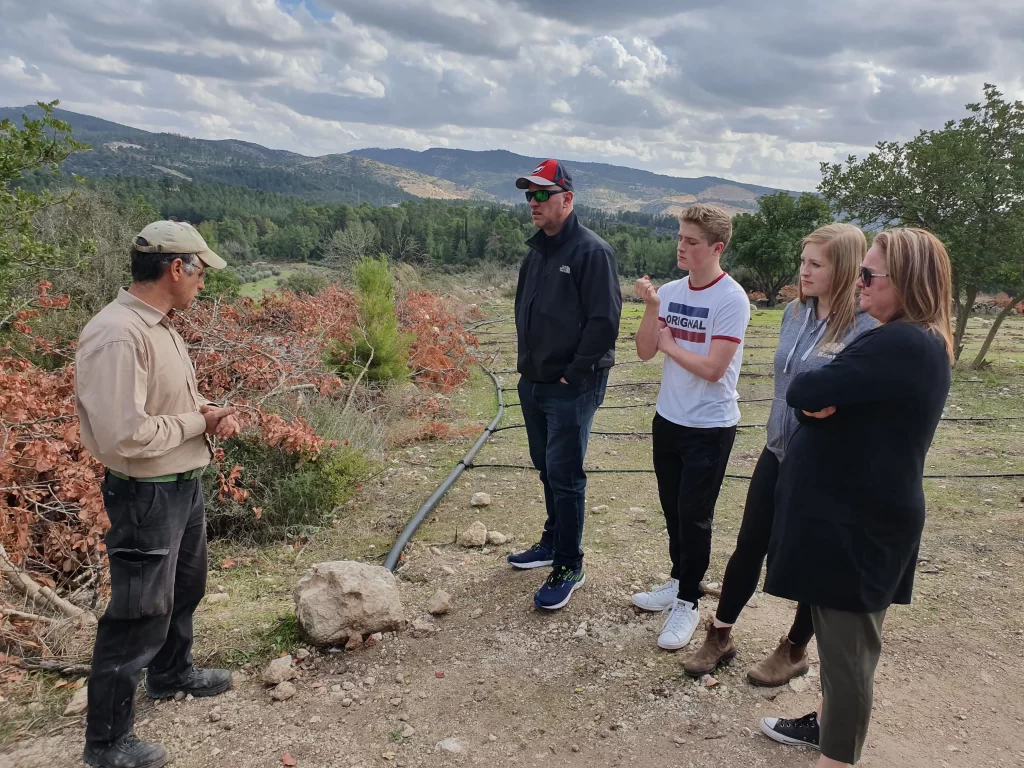
We follow him and receive our saplings, which we will plant in the stony ground. These are tiny trees that have been grown in the nearby nursery of JNF-KKL. Eran dips the root-ball in a bucket of water, saturating it, telling us the name and kind of tree before handing it to us. Each of us holding a sapling, we follow Eran down the hill, to the site where we will plant. Small pits have already been dug for the planting. We each bend down, knees on the ground, set the sapling in the pit, cover it with the dirt around. It is an amazing feeling, giving life to a tree in the land of Israel. You lift your head and look around. Everyone has a smile on their face, and in the background, we see older trees and green forests that give us an idea what our little saplings will look like in the future.
I always recall the Talmudic story about Honi, who finds a man planting a carob tree. Honi asks the man, “How long will it take until the tree bears fruit?” and he answers, “It can take a long time, even up to seventy years.” Honi, astonished, asks, “So why do you plant this tree? You will not even live to enjoy it!” The man answers, “Just as I have found this world planted by my ancestors, and I enjoy their effort and labor, so, in the same manner, I labor and plant for future generations to enjoy from what I’m planting today.”
The lesson of Dor Ledor (generation to generation), jumps out of the story. We are a link in a chain, and we must make sure to forge our own link for future generations. Our tree is established on the deep and strong roots of previous generations. But this story has an even deeper message, a message of process, time, investment and perseverance. This is a message that even Honi must learn, after his previous encounter with God, in which Honi demands rain in the time of a drought, demands instant interference, instant gratification if you wish. The Talmud tells us that Honi fell asleep for seventy years, and after he awoke, he saw a man picking the fruit of a carob tree. Soon he learned that this was the tree and this was the grandson of the man who planted that tree seventy years ago. Following this, Honi wanders into a Beit Midrash, a house of study, and finds the Sages debating a matter of Halacha, Jewish law. As the questions arise, one of the Rabbis points out, “This is what Honi said on the matter.” Hearing this, Honi speaks up, “I am that same Honi you are referring to”, but the sages did not relate to him. Honi realizes that no one would partner to study with him, and so he turns to his Creator and asks G-d to take back his soul.
The second half of the story teaches us another lesson, the lesson of being part of the process. Not only do important matters take time, not only do they need soil, solid ground for roots to flourish in, they also need watering, pruning and taking care of. You must be part of the process, for if you jump straight to the outcome, straight to the end, you will be so foreign to it, that no one will recognize you, no one will know who you are and what you did. That is what happened to Honi, who skipped seventy years of growth.
I would dare say that it is not a coincidence that this message is being relayed today through the earth, the soil of the Land of Israel. Eretz Yisrael and The State of Israel are one of the pillars of our people, and our connection to the past. Our hopes for our future generations must have a connection to the land and to the State of Israel. This idea is also taught to us through the Hebrew language itself. In the Tanach (Bible), we read that the land of Israel is blessed with seven species of plants. Each one of these species has a specific and unique verb in Hebrew for their harvest, and its own specific and unique name for its season of harvest. Thus the Hebrew language tells us that we have a relationship with this Land, and our relationship must be a productive one, one that flourishes and brings growth to the land.
In the same manner, we are promised in the Tanach (the best known example is in the Shema), that if we follow the Ways we are expected to, God will reward us with auspicious rains which will provide us with sustenance from the land.
I always wondered about the Hebrew verb Lehagshim, meaning to fulfill, to realize, but having at its root the meaning of bringing rain. When a cloud brings rain, Magshim, the rain bathes the seed in the ground, and together they bring sustenance to the world. In the words of Naomi Shemer (Kmo Chatzav) “As a cloud to bring rain, over an empty field, and to bring to the clod, the green message.”
As I pointed out, Lehagshim also means to fulfill, and is used in the meaning of fulfilling a dream. The Hebrew linguists will tell you it comes from the root word that means personification. In this way, fulfilling a dream is making something become real. To me, the fact this word has two meanings, deriving from two different roots, allows me to make a little Midrash on words. When a cloud fulfills itself it brings rain, that rain brings life to the field. In the same way our plans and dreams must be positive, saturating, nursing, and giving/ creating life in the world.
Our language takes many words from the land, from its agricultural, reminding us all the time of our personal and collective-national relationship with this land.
Eran, the Forester, offers to conclude our work with the prayer for tree planting, originally composed by Chief Sephardi Rabbi Ben Zion Meir Hai Uziel. In this prayer, we ask the Creator to look after our trees, and provide them with all that is needed in order for them to flourish and succeed. The prayer also asks the Creator to ‘strengthen the hands of all our brethren who toil the land and make its desolate areas fruitful. ‘Bless, O Lord, their might, and may the work of their hands find favor before Thee.’ It always moves me as we say this with Eran standing before us.
Today, you can drop a pin on Google Maps or any other geographical application on your cellphone and save the location where of the tree you planted. So next time you visit Eretz Yisrael, you don’t have to ask your guide to find your tree, rather you yourself can take him to your tree, your link to the Land of Israel and its generations.
